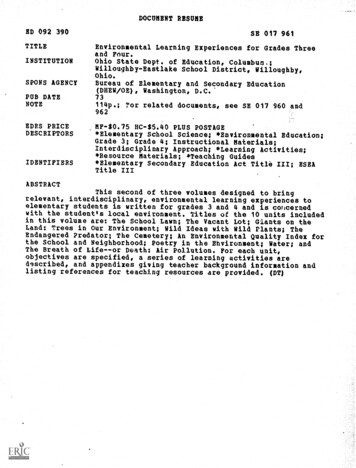
Transcription
DOCUMENT RESUMEED 092 390TITLEINSTITUTIONSE 017 961Environmental Learning Experiences for Grades Threeand Four.Ohio State Dept. of Education, Columbus;Willoughby-Eastlake School District, Willoughby,Ohio.SPONS AGENCYPUB DATENOTEEDRS PRICEDESCRIPTORSIDENTIFIERSBureau of Elementary and Secondary Education(DREW /OE), Washington, D.C.73114p.;or related documents, see SE 017 960 and962MF- 0.75 HC- 5.40 PLUS POSTAGE*Elementary School Science; *Environmental Education;Grade 3; Grade 4; Instructional Materials;Interdisciplinary Approach; *Learning Activities;*Resource Materials; *Teaching Guides*Elementary Secondary Education Act Title III; ESEATitle IIIABSTRACTThis second of three volumes designed to bringrelevant, interdisciplinary, environmental learning experiences toelementary students is written for grades 3 and 4 and is concernedwith the student's local environment. Titles of the 10 units includedin this volume are: The School Lawn; The Vacant Lot; Giants on theLand: Trees in Our Environment; Wild Ideas with Wild Plants; TheEndangered Predator; The Cemetery; An Environmental Quality Index forthe School and Neighborhood; Poetry in the Environment; Water; andThe Breath of Life--or Death: Air Pollution. For each unit,objectives are specified, a series of learning activities aredescribed, and appendixes giving teacher background information andlisting references for teaching resources are provided. (DT)
U S (APARTMENT OF HEALTH.EDUCATION ISNESITARENATIONAL INSTITUTE OFEDUCATIONTHIS DOCUMENT HAS BEEN REPRODUCED EXACTLY AS RECEIVED FROMTHE PERSON OR ORGANIZATION ORIGINAUNC, IT POINTS OF VIE A OR OPINIONSSTATED DO NOT NECESSARILY kEPRESENT OFFICIAL NATIONAL INSTITUTE OfEDUCATION POSITION OR POLICYEnAronmentalLearning Experiencesfor Grades Threeand FourOhio Departmentof EducationPrepared byCenter for the Developmentof Environmental CurriculumWilloughby-Eastlake City SchoolsColumbus, OhioWilloughby, Ohio1973Funded by an ESEA Titlegrant
STATE BOARD OF EDUCATIONJohn R. Meckstroth, President, CincinnatiWilliam H. Coss ler, VicePresident, YoungstownWilliam M. Baker, MadisonWallace E. Blake, ZanesvilleThaddeus Garrett, Jr., AkronSusan D. George, CantonWilliam M. Judd, CincinnatiEverett L. Jung, M.D., HamiltonRobert A. Lyons, Sr., DaytonMildred R. Madison, ClevelandRoy D. McKinley, CoshoctonWard M. Miller, PortsmouthGene Norris, BereaDavid R. Rittenhouse, ToledoAnthony Russo, Mayfield HeightsThomas J. Russo, Maple HeightsWayne E. Shaffer, BryanCecil M. Sims PiquaFrances S. Vile, ColumbusPaul L. Walker, BexleyRobert W. Walker, AdenaRobert E. Williams, XeniaMartha W. Wise, ElyriaThe continuing thrust toward environmental awareness has brought increasing realization that environsment encompasses the totality of man's surroundings,both living and non-living, natural and man-made.Environmental concerns should not be separated fromother areas of knowledge.Increasingly, the need has been felt for teachingmaterials which would assist educators to infuse en.vironmental concepts into existing curricula in a meaningful way. Environmental education should be a partof learning at all grade levels.In response to this need, the Ohio Department ofEducation has developed a series of publications toassist schools in implementing an interdisciplinary approach to environmental education. The publicationsencompass a resource catalog; guides to distinct Ohioenvironmental study areas; a series of experience units;and a planning guide for outdoor education.A Center for the Development of EnvironmentalCurriculum was established in August, 1971, in theWilloughby-Eastlake City School Eistrict under anESEA Title III grant administered through the De.partment of Educatiors. The units in this volume weregenerated from materials developed by the Center andpilot tested in sixteen elementary schools in Ohio.This collection of units is one of three volumes designed to assist teachers in bringing relevant, interdisciplinary environmental learning experiences to Ohioelementary students.Martin W. EssexSuperintendent of Public Instruction
Table of ContentsPageIntroduction2The School Lawn3The Vacant Lot15Giants on the Land: Trees in Our Environment 26Wild Ideas with Wild Plants47The Endangered Predator63The Cemetery67An Environmental Quality Index for the Schooland Neighborhood63Poetry in the Environment81Water87The Breath of Lifeor Death: Air Pollution93
IntroductionIA order to provide a basis for construction of theseunits, the Center for Development of Environmentalworld as they manifest themselves in any body ofCurriculum analyzed several new curriculum programsSines environmental education impinges on everyaspect of living and learning, these units are not Intended to be taught as a separate subject, but to beintegrated into the existing curriculum. Also, theirarrangement in these pages implies no pre-orderedsequence in which they should be presented, thoughcertain units have been placed before others becausethey present concepts basic to further understanding(for instance, Food Chains precedes Food Web).For an environmental program to be successful, objectives must be identified in order to direct the experience toward the desired outcome. The Center forin environmental education and science. One, theNational Environmental Education Development program, was responsible for developing the strand ap-proach to education. This approach is a strategy oflooking at the world that ties the various fragments(like mathematics, music, history, and biology) intoan understandable whole. Through the strands patterns, adaptation, change, interdependence, and diver.sity, or PACID a child begins to see that the worldreally is an indivisible fabric of matter and energy intowhich he himself is firmly stitched.Man and His Environment, a National EducationAssociation publication (Washington, D.C., 1970), provides the following definitions of the PACID strands:Patterns: Organizational patterns are kinds ofstructures that may be found in rock formationsas well as in social groups of people and animals.Functional patterns include traffic movement andclassroom schedules. Spatial arrangements arepatterns that often please us. Such patterns occurboth in nature and in artistic design.Adaptation: Over extensive periods of time, agreat number of changes come about in order toenable an organism to adapt to the environment.Hereditary factors then preserve the continuingelements. The characteristics that enable the organism to adapt best are apt to be the traits passedon from generation to generation, thus ensuringsurvival of the species.Change: Living and non-living things are con-stantly changing, whether among galaxies andplanets or within body cells and body systems.Some things remain the same in spite of change.Matter and energy may change in form, but theycan never be created or destroyed.Interdependence: Nothing exists in isolation.knowledge.Development of Environmental Curriculum has identl.fied the following objectives of an environmental cur-riculum for kindergarten through grade six:Critical thinking skillsProblem identification and solution skillsKnowledge of the biophysical and sociocultural conceptsDecision makingValue and value formationDefinition of prioritiesPersonal environmental philosophyAvenues for maintaining or changing theenvironmentFor a program to be effective, it must also have anorganizational strategy. The direction in these unitsis from a heavy emphasis on affective experiences inthe early grades to development of skills and contentin grades five and six. In order to relate the curriculumto the conceptual development of the student, theenvironmental units consider progressively larger andmore complicated environments.The first level, from kindergarten through secondgrade, deals with the immediate environment. Thisis the environment that a student can directly experience in his immediate vicinity, on his level, one conceptEach individual is constantly interacting with living and non-living things: his family, his belongings, his friends and his world. These people andthings also depend on the individual in order tofunction properly. The process is continuous asat a time one tree, one kitten, one terrarium .The units for grades three and four are concernedwith the local environment, which includes what thestudent can directly experience by moving from onelocation to another: from the classroom to the cafe-life forms nourish the living.Diversity: Many likenesses and differences occur among living and non-living things. A varietyof functions, sizes, and structures exist in plantsand stars, rocks and animals, processes and people. Yet there are sufficient similarities to permitto the meadow. Students consider both individualspart of the life cycle even after death, for deadteria; the school building to the school yard; the forestwithin the community as well as communityorganization.The third level includes grades five and six, andtheir classification into orderly patterns. Thesedeals with the community environment. This environment may be a woodlot, a pond, a city block, a town,or a city. Students directly experience portions of theclassifications increase one's understanding of hismaterial, but they also have vicarious experiencesworld.PACID, then, provides the conceptual orientation forthese units. These principles form a basis for identifying, organizing, and studying the workings of thethrough audio-visual materials or readings. Emphasison socio-cultural and biophysical concepts increases.The skills of problem solving and critical thinking receive additional attention at this level.
The School LawnAlmost every house has a lawn or the residents thereare trying to grow one. What a strange custom, cuttinga bunch of little grasses all to one length as if we wereTABLE,QF CONTENTS;ObjectivesExperiencesPatterns on the School LawnAdaptation on the SchoolChange on the School LawnInterdependence on the School LawnDiversity on the School LawnMen and LawnsAppendixVocabulary ListReferencesBooksFilmsFilmstripstrying to create a carpet in the woods. Not only dohouses have lawns but most of our public buildings dotoo, including the school, Because the lawn is such acommon feature, it offers a perfect opportunity forstudying some basic ecological principles and small insect life. A good healthy lawn is like a small ecosystemand offers the child a chance to see an ecosystem inaction. This unit is a good starting point for the uniton the vacant lot, the trees, or the wild plants,Film loopsPeriodicals3,Page444681012131813131313
THE SCHOOL LAWNthe custodian's assistance on this expe4etus, as his advice will be useful and may save them a lot o: time andtrouble.Unit Oblectives:The student will be able to1. draw a rough representation of the people pathsAdditional ActivitiesIf you had the opportunity to design a new schoollawn plan, what would you do? One large college inthe east put in no sidewalks for he first two years.People could walk wherever they wanted to Altorthe people paths were well established, sidewaksthat criss-crossed the school lawn he studied.2. relate the place of color in animal adaptation.3. list three changes that took place in the 10-footsquare area of the school lawn that he used for anobservational study.4. distinguish between grass that has been grown dependent on water, soil, sun, and air and grass thathas been grown independent of each of these lifegiving substances.5. list one of each object he found, in his micro- andmacro-search of the school lawn, in the categories:a, Animal, b. Non-living, c, Plant.were built on top of them. Design a new plan foryour school lawn; consider play areas; use hedgesand other plants to enclose areas or channel peoplecertain ways. If possible, discuss your recommendation with the principal or other school officials.Observe and map other areas for people paths.Discover why grass doesn't grow in people paths.Using two large #10 tin cans with both ends removed, put one can into a people path and one intoa grassy lawn area. Fill each can with water andtime how long it takes for the water to percolate(soak) into the soil. What effect does this have onthe suitability for growing things?Environmental Experience 1: Patterns on the SchoolLawnIn any lawn, many patterns can be seen, and a schoollawn is no exception. The patterns we are looking forin this experience will be called people paths. Mostschool lawns have certain areas where no grass willgrow because of the constant use by students and visitors to the school. The shortest distance between twopoints is a straight line, and if that line means walkingover the lawn, it will usually be done that way. Ircases where the pavements are too narrow for theMaterialsDrawing paper or graph paperTwo different color pensStakes or sticksStringPoster paper for signsTrowelMagic markersGrass seedEnvironmental Experience 2: Adaptation on the SchoolLawnColor is a major form of adaptation for many plantsand animals. Tropical fish have bright colors to helpthem hide in the coral reefs; some insects have colorsthat help them blend with plants; many flowers havebright colors to help attract insects for pollination. Fordefense, many mammals and reptiles take on the colorof the habitat in which they live. What is adapted toliving in the school lawn community and what colorsshould they be to survive? Using at least four boxes ofnumber of people using them, paths will show no onone or both sides, By mapping the area, the stuckiltscan find where the major flow of people is concentrfarin both entering and leaving the school building. Using;a base map of the school grounds or graph paper, havethe students map your school's people paths. Aftermapping these paths try to design and implement alternate routes. Block off the present people paths usingstakes and string. Place warning signs on the stringsto keep people oft If possible plant grass seed on thepath areas, working the soil before you do to promotegrowth. Grass seed can be purchased for a minimalprice at any hardware or garden store, and in manycases, stores will be happy to donate a small amount tobenefit the school project. The students should requestcolored toothpicks (blue, green, yellow, red, and natural wood) distribute these in a designated area of thelawn (e.g., a 20' x 30' rectangle). Count the total number of each colored toothpick before distributing. Pusheach toothpick into the grasser dirt so that it does not4
Sample Map of School Grounds-- People PathsLocust LanePaved WalkExit wExitBlacktopSCHOOLEntranceDrivewayExitCenter Street31st AvenuePaved WalkBeaumont Drive
show above the level of the grass. Divide the class intogroups of three students each. For fun, have each childpredict how many of each color will be found beforeevery day. What are these changes and how can you seethem? Rope off a tensquarefoot area using four sticksyou begin. When you are ready to begin, release thestudents. Average time given should be 16 minutes.When the time is np, return to the classroom and tallyup the results, The group with the most toothpicks canbe declared the "winner."ing the week, or once during each of the seasons. Whatand a string. This will be your laboratory area or observation area. Observe this plot as many times as youcan, either at the same time every day, randomly dur-has changed? Are there new flowers or plants? Arethere spider webs in the grass or an ant's nest underthe big rock? Or maybe the rock is no longer In theplot, having been moved either by man or by rain.Using a chart like the one following, note the animalsand plants present in your plot and how they changeHow many of each color were found?What was the hardest color to find?What was the easiest color to find? Why?If you were a bug, what color would you be? Why?If you were a red bug, where could you live? If youfrom observation to observation.had to live in the lawn, what could you do forprotection?How does man use camouflage?Additional ActivitiesHave the children now make believe they are animals looking for something to eat, The food is theremaining toothpicks on the lb.wn. See which stu-dents would perish because they could not findenough food to eat, and which students would survive because they could obtain food.Study in more depth the different forms of animaladaptive coloration. Show a movie on how animalsprotect themselves through coloration and othermeans. See bibliography for suggestions. Have eachchild make a report about one of these animals.Draw a picture of an animal using adaptive coloration and try to hide him in the background of thedrawing.Collect some of the trisects that live in your schoollawn and discover their adaptive coloration.Additional ActivitiesDo a base study of your plot first. What animalsand plants lived there when you started? Diagramthe location of the plot's feature on graph paper.MaterialsFour boxes of colored toothpicks (red, blue, green, yellow, and natural wood)Each time an observation is made, draw a new graphof the changes.Environmental Experience 3: Change on the SchoolExperiment within your plotmScatter seeds andLawnOur world changes every day. Buildings are torn down,food for animals and observe what happens.highways are built, forests are cleared and houses arebuilt. These are large changes, easily seen. But what ofthe changes that are so small that they can't be seenuntil enough has taken place for us to notice, such as aMaterialsPlot observation chartPencilsRulers or tape measurescar rusting or a flower growing? The school lawn is muchMagnifying glassesMicroscopes (if wanted)Stakes or sticksStringlike that, for unless the change is great, bulldozersmoving earth or the janitor cutting grass, it often seemsthat nothing is changing. But changes are taking place6
PLOTOBSERVATION CHARTAnimalsColorNumberAmphibians'c4*-;r?;;:4Size orLocationBirdsReptilesGrasses\\ rAlkokargfekei./.,.Mosses, Lichen, Fungi0,.2tit,. ir4.,.Avi,-.0,iInsects, Wormsxk--,41P.f,'.\',0\.--:,;51eInztotsvs 6".'''Weather4*.eALVA.\'OtherLitterTracks7Remarks & Other
Environmental Experience 4s Interdependence on theSchool LawnPart 1: PlantsThe school lawn is a small ecosystem or community oforganisms interacting with the environment. The community depends upon and is influenced by the habitat,the specific set of conditions that surround the organ.isms such as sunlight, soil, minerals, elements, mois-ture, temperature, and topography. Plants, a part ofthe community, are dependent upon water, air, sun,and soil. Set up an experiment showing necessity ofthese elements to plant growth.Step 3: Cover top of soil with grass seeds. Gently pressseed into soil.Step 4: Water (except pot 3) so that soil is all wet.General Planting Instructions:Step is Place several rocks over hole in bottom of fivemedium size clay pots.Pot 1: Good Soil, Water, and Sun (Control)Instructions:1. Good soil (buy from garden supply).2. Water: Twice a week so that soil is evenly watered,no water standing on top of soil.3. Place in a sunny window.Step 2. Fill pots with soil (or rock mixture), leaving atleast 3/4" at top.8
Testing: SoilPot 2: Rocky Soil, Water and SunInstructions:1. Use rocky soil: A mixture of gravel, sand, and soil;3. No Sun: Place in closet or under box.gravel, Y4 sand, and Y4 soil.2. Water: Twice a week so that soil is evenly watered;no water standing on top of soil.3. Place in sunny window.Observation Schedule:1. Before planting, take a poll of the predictions of theoutcome of the experiment (form a hypothesis ofthe outcome). Keep a written copy of the predictions.2. Set up experiment, making sure each pot is labeledso that they are not confused; also make sure theplants are watered only at the prescribed time.3. This experiment probably will last two weeks.4. There will be two major observations, one at theTesting: WaterPot 3: No Water, Good Soil, and SunInstructions:1. Use good soil.end of the first week and one at the end of the secondweek,2. No water!!3. Place in sunny window.5. Do not view pot 5 at all during the first week, so asnot to expose it to light.6. Observations to be made at the end of the first week:a. Are any grass plants shoving?b. If so, approximately how many? Light growthMedium growthHeavy growthc. What is the general height of the grass?d. What is the general condition of the grads?Color:GreenYellowTexture:Pot 4: Too Much Water, Good Soil, and SunInstructions:WhiteBrownThick and strongThin and limpBrown and dry7. Based on your observation, form hypotheses as towhat the plants will look like at the end of the second week. Keep a written copy of observations, and1. Use good soil.2. Too much water: water heavily every day.3. Place in sunny window.predictions.8. At the end of the second week, observe the plantsagain using the same criteria.9. Review your predictions and summarize the outcomes.At the end of the two weeks, discuss the dependenceof plants upon the elements sunlight, water, and goodsoil. How would the absence of these affectschoollawn? What would happen to the food chains if any ofthese elements were missing?Additional ActivitiesContinue the experiment using actual soils fromTesting: LightPot 5: No Sun, Good Soil, and WaterInstructions:your school lawn.See if you can revive the plants from the first experiment by adding the element that was missing. Dis-1. Use good soil.2. Water: Twice a week, so that soil is evenly watered;no water standing on top of soil.cuss fertilizers and rotation of crops. Discuss theeffects of pollution on the growing of plants.Carry out the original experiment in the school9
lawn, if possible. Sunlight can be blocked out witha box. Metal stripping can be used to divide sections,of turf.then filled with the ant-dirt mixture, leaving a two orthree inch space at the top. The dirt should be takenfrom the ant nest so that you have ants in every formof development. The queen ant is usually not too hardto recognize due to her large size. You must providefood and water for your farm. Put a few insects orpieces of honey or molasses on a small piece of breadfor food and water-soaked cotton as a source of water.MaterialsFive medium sized clay potsPotting soil from a garden shop or nurseryGrass seedSmall rocks for drain, leSand and gravelWatering canLabels for potsTrowelRuler for measurement of plantsPencilsObservation sheets or notebooksPart 11: AnimalsDependence means needing something or someone inorder to survive. The plants were dependent upon thesun, the soil, and water in order to grow and survive.The animals in turn are dependent upon the plants forfood in order to survive.Additional ActivitiesObserve how other animals are dependent uponeach other for food and protection.1:1 Build other insect communities and observe howthey are dependent.MaterialsWooden slats or boardsAnd eventually the soil is dependent upon the decomposition of the plants and animals to obtain mineralsto start the process over again. But dependence forTwo pieces of glass the same sizeExposed x-ray film or colored celophaneDirt and antsCottonsurvival is not only present between plants and animalsand between different types of animals, but it is presentFoodright in animal groups. Dependence and cooperationcan be seen in bird Rocks, wolf packs, honey bees, andmonkey groups. Cooperation and dependence can alsoEnvironmental Experience 6: Dive rsity on the SchoolLawnIn this experience, the children all become big-gameexplorers. Since it would be impossible to have thechildren depart for a field trip to the African continentto stalk lions, elephants, and water buffalo, they cando the best possible thing and 'explore the lawn of theschool. Since this is a much smaller area they can besearching for much smaller plants and animals. But if,like the African continent, the school lawn is a healthyenvironment, then it must be diverse in its plant andanimal species. The large animals that might be foundaround the lawn would be mice, squirrels, dogs, cats,rabbits, chipmunks, birds, or reptiles. The smaller animals could include insects, worms, spiders, small am-be seen in human families. Cooperation in food getting,protection, rearing of young and home building are onlya few of the ways animals depend on each other. Anexcellent opportunity to see animals' cooperation atwork is in an ant colony or ant farm. They are easyto construct, maintain, and interesting to watch. Thesimplest type of ant farm is made of two pieces of glassset in a wooden frame. The frame and glass can be anysize, depending on the size of farm you want. The glasspanels should be set about one inch apart. See diagramfor details. The glass should be darkened with someopaque material such as colored plastic or a piece ofexposed x-ray film from your local hospital. This is10
Lawn Diversity ChartANIMALSPLANTS11NON.LIVING
phibians, or small reptiles. Plant 'matter could includegrasses, wildflowers, shrubs, trees, leaves, or seeds.grass, and its arrival is stranger still. It is now believedthat this type of grass came by accident in the fodderfor the cattle on Hernando de Soto's ships. Many of theweeds, such as the broadleaf plantain, are also thoughtto have come this way to the New World. How do youfeel about grass and lawns? What if the explorers neverbrought grass with them? What would our yards lookNon-living matter would include soil, rocks, water,metals, or plastics. While biggame explorers are armedwith expensive paraphernalia and ammunition, thechildren can be aimed with binoculars and magnifyingglasses, if available.like then? What benefits do we receive from havinggrass lawns? What have we lost because forests havebeen replaced by lawns? What should be done, if anything? For example, should your school lawn be madeinto a forest like it might have been at one time? Setup a hypothetical panel discussion to decide the fateof your school lawn.Here are some questions to use as guidelines in yourdiscussion:Questions for Panel DiscussionPro Cultivated Lawn:1. How beautiful would the school look with a fieldDivide the class into small exploring parties of threegrowing around it?2. Would the taxpayers who pay the bill for the schoolpermit a ragged field growing around it?3. Would the mosquito and other insect ,problems increase?4. Would there be any danger of poison ivy, stingingto six each. Each group will be given a pair of binocularsand a magnifying glass. The first search will be withthe binoculars. The children will investigate those areasaround the school lawn that they cannot see closelyenough. Elect an exploring party secretary, who willwrite down all the plants, animals, and non-living matter that they observe. Next, conduct a microsearch ofnettle, or other of these types of plants occurringin greater abundance?5. Shouldn't this effort be directed at a land laboratoryrather than the school lawn?6. Would the field eventually obscure the school fromthe road, thus increasing danger of children beinginvolved in automobile accidents?the lawn on hands and knees using magnifying glasses.Again write down any plants, animals, or non-livingmatter observed. A chart is provided to make this taskeasier.After this part of the experience is completed, thechildren can return to the classroom and discuss theirfindings. They may find that the school lawn is madeAnti Cultivated Lawn:1. Wouldn't the use of fertilizers, herbicides, and thelike, that endanger the environment, be greatly reduced?2. Wouldn't the field attract many more birds and predatory insects, thus reducing the need for insecti-up of many more organisms and objects than theythought possible. If the lawn were allowed to grow intoa field there would be many more things available, butthey would be different.What does a lawn look like when it is not well kept?What is a vacant lot? Is it the same as a neglectedlawn? Would there be more animals in a cared-forcides and pesticides that so greatly damage ournatural environment?3. Couldn't the field be used as an important environmental study area for the school children?4. Wouldn't turning the lawn into a field greatly reducethe time the custodian had to spend taking care ofit, thus saving the taxpayers' money?5. How can the taxpayers complain when the schoolsare supposed to be for the students?6. Shouldn't the schools be less interested in beautythan in giving the students the best education pos-lawn or an over-grown lawn or would there be differentanimals? Visit an over-grown lawn and observe it asyou did the school lawn. What differences did you find?Compare your results.Environmental Experience 6: Men and LawnsDid you ever wonder where and when lawns really gotstarted? Whoever thought to cut all the grasses to thesame length making a carpet outdoors? Believe it ornot, most of the grass types in our yards today are notnative to America and had to be imported. The famousKentucky bluegrass, which is a native of Greece andsible?Additional ActivitiesResearch the history of lawns in America and thespread of lawns in your town.is mentioned in ancient writings, was supposedlybrought to the new world by the French explorers, Mar-quette and La Salle. Part of their missionary work tothe Indian included the distribution of seeds. So bluegrass was already well established and thriving yearsbefore any American settlers came to Kentucky andOhio. Another common lawn grass is called BermudaStudy and read about foreign plants and how andwhy they were brought to America.Invite your school custodian or lawnkeeper to attend or take part in your panel discussion.12
AppendixVocabulary ListCamouflageAdaptationMimicryCommunity or ecosystemInterdependenceDiversityPeople pathProtective colorationInsects, 29 frames, Color, Society for Visual Education,1345 Diversey Parkway, Chicago, Illinois 60614.Living Things Through the Ages, Series of 4, Color, Encyclopedia Britannica Educational Corporation, 425N. Michigan Ave., Chicago, Illinois 60611.Age of the Earth and Living
Willoughby-Eastlake School District, Willoughby, Ohio. SPONS AGENCY Bureau of Elementary and Secondary Education (DREW /OE), Washington, D.C. PUB DATE. 73 NOTE 114p.; or related documents, see SE 017 960 and. 962. EDRS PRICE MF- 0.75 HC- 5.40 PLUS POSTAGE DESCRIPTORS *Elementary School Science; *Environmental Education;










